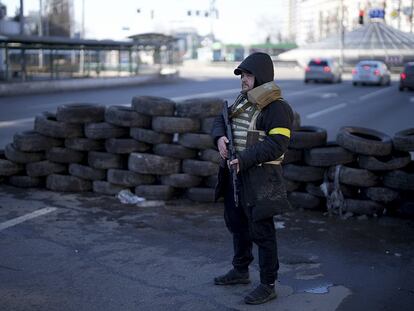Kyiv: A besieged and deserted city
While many residents have fled the Ukrainian capital, groups of youngsters have remained behind to fight Russia’s invading forces
At 6am on Sunday, the doors of Kyiv’s central station opened up and a large crowd that had been waiting outside began to stream in, filling the facility to the seams. There were hundreds, maybe thousands of people standing in the hallways, vestibule and platforms of Kyiv Rail Terminal, waiting to get on a train out of the Ukrainian capital.
As Russian troops on Monday continued to try to take control of Kyiv, the city was coming under increased pressure from the bombings, the street fighting and the power cuts, and many people were trying to flee to the Polish border. The trains, brimming with passengers, pulled slowly out of the station, even as other Ukrainians were arriving in Kyiv from other parts of the country. But military personnel were preventing them from exiting the station because of a curfew in place until 8am on Monday.
Not that there were any buses or taxis to be found near the station anyway. A story was circulating that a two-kilometer taxi ride now costs over $200, but it was a difficult claim to either prove or disprove, since no taxi driver dared come near the station.
One of the individuals providing information about the curfew was Vassili, 30, a member of the Ukraine’s territorial defense units. Armed with a gun, he repeatedly warned passengers that it was very dangerous to walk out of the station because Ukrainian soldiers could take them for a Russian soldier or an opponent and open fire, no questions asked.
Vassili, who is married and has a daughter, said he comes from the Donbas region in southeast Ukraine, parts of which have been under pro-Russian separatist control since 2014. He said he was forced to flee to Kyiv because of disputes with pro-Russian residents. “I am not afraid to die while confronting the Russians,” he said, wearing a yellow armband on top of his winter jacket so people could identify him as a member of the defense units.
Early on Sunday, the sound of the blasts was constant and regular, coming in every half-hour. On the third day of Russia’s military offensive, the streets of Kyiv were deserted. On the broad avenues that crisscross the city, there were no pedestrians and no cars except for military vehicles, police patrols and ambulances. There was no light to be seen inside homes and the curtains were drawn, following orders from the authorities. All stores were closed, as were the entrances to the underground rail system, where watchmen ensured that nobody tried to go in or out.
There were not many military checkpoints in the city center, but the avenues connecting to outbound roads were under army custody. From time to time, a small group of men could be seen in the area. Five young men who looked around 20 years old said they were looking for a place to enlist, and they stopped every car that went by to ask for information. All of them said they were anxious to help defend the city.
Another group of men who looked in their thirties said they were looking for military units in order to get their hands on weapons to fight the Russians. All the while, sirens and explosions continued to blare in the background.
Around 50 Ukrainian soldiers were standing guard on Podilsky bridge. Some were pointing their weapons towards the bridge entrance, while others were piling sand bags around the base. They were getting ready for a Russian offensive and seemed prepared to defend the bridge at any cost. It was evident that there had already been fighting in the neighborhood: there were three dead bodies lying on a nearby street. One of them was still bleeding profusely.
Tu suscripción se está usando en otro dispositivo
¿Quieres añadir otro usuario a tu suscripción?
Si continúas leyendo en este dispositivo, no se podrá leer en el otro.
FlechaTu suscripción se está usando en otro dispositivo y solo puedes acceder a EL PAÍS desde un dispositivo a la vez.
Si quieres compartir tu cuenta, cambia tu suscripción a la modalidad Premium, así podrás añadir otro usuario. Cada uno accederá con su propia cuenta de email, lo que os permitirá personalizar vuestra experiencia en EL PAÍS.
¿Tienes una suscripción de empresa? Accede aquí para contratar más cuentas.
En el caso de no saber quién está usando tu cuenta, te recomendamos cambiar tu contraseña aquí.
Si decides continuar compartiendo tu cuenta, este mensaje se mostrará en tu dispositivo y en el de la otra persona que está usando tu cuenta de forma indefinida, afectando a tu experiencia de lectura. Puedes consultar aquí los términos y condiciones de la suscripción digital.
More information
Últimas noticias
NASA discovers Titan doesn’t have an ocean, but a ‘slushy ice layer’ that increases possibility of life
Innocence lost in the forest of the child soldiers: ‘Each leader of the armed group had his girls’
‘Fallout’ or how the world’s largest company turned an anti-capitalist apocalyptic Western into a phenomenon
From inflation to defending migrants: Eileen Higgins and Zohran Mamdani inaugurate the new Democratic resistance against Trump
Most viewed
- ‘El Limones’ and the growing union disguise of Mexican organized crime
- Christian Louboutin: ‘Young people don’t want to be like their parents. And if their parents wear sneakers, they’re going to look for something else’
- The low-cost creative revolution: How technology is making art accessible to everyone
- ‘We are dying’: Cuba sinks into a health crisis amid medicine shortages and misdiagnosis
- A mountaineer, accused of manslaughter for the death of his partner during a climb: He silenced his phone and refused a helicopter rescue











































